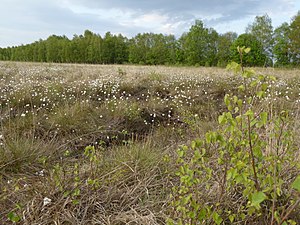Northern and Middle Wietingsmoor, Freistätter Moor and Sprekelsmeer
|
Northern and Middle Wietingsmoor, Freistätter Moor and Sprekelsmeer
|
||
| location | South of Twistringen , Diepholz district , Lower Saxony | |
| surface | 2789 ha | |
| Identifier | NSG HA 249 | |
| WDPA ID | 555690892 | |
| Geographical location | 52 ° 41 ′ N , 8 ° 39 ′ E | |
|
|
||
| Setup date | 2nd November 2018 | |
The Northern and Middle Wietingsmoor, Freistätter Moor and Sprekelsmeer is a nature reserve in the Lower Saxon cities Twistringen and Sulingen , the municipality Ehrenburg in the joint community Schwaförden , the communities Wehrbleck and sanctuary in the joint community Kirchdorf and communities Eydelstedt and Drentwede in barnstorf in district Diepholz .
General
The nature reserve with the sign NSG HA 249 is approximately 2789 hectares . It is completely part of the almost 2,816 hectare FFH area “Wietingsmoor” and a large part of the EU bird sanctuary “Diepholzer Moorniederung”, which consists of four sub-areas and is 12,648 hectares in size . In the north the nature reserve borders partly on the landscape protection area "Nördliches Wietingsmoor", in the middle area partly on the landscape protection areas "Weddigeloh" and "Sprekelsmeer" and in the southeast on the landscape protection area "Wackelberge and adjoining landscape parts". The area has been under nature protection since November 2, 2018. In it are the previous nature reserves " Nördliches Wietingsmoor ", " Mittleres Wietingsmoor ", " Freistätter Moor " and " Sprekelsmeer " as well as small parts of the "Weddigeloh" landscape protection area due to the adaptation of the boundary lines. risen. The responsible lower nature conservation authority is the district of Diepholz.
description
The nature reserve is located south of Twistringen. It places several raised bog areas under protection, which were extensively peated in the past . Large parts of the former mining areas have been rewetted so that they can regenerate. They are often characterized by open and predominantly wood-free raised bog areas. Sometimes there are humid and peat moss-rich cotton grass lawns and bog heaths . Furthermore, large parts of the nature reserve are occupied by bog forests . Pipe grass meadows are also formed, especially in drier locations. In places raised bog areas have not been pitted. There are several peat pests in the north of the nature reserve . In particular, the edge areas of the peated high moor were cultivated and used as grassland . These also serve as a buffer to the intensively used areas outside the nature reserve. In the northern Wietingsmoor, the grassland areas partially extend into central areas of the moor. The Freistätter Moor is largely characterized by grassland areas.
The rewetted mining areas and preserved bog remains home to some highly typical bog vegetation with Scheidigem cotton grass , bell and rosemary and cranberry . Brown and beak sedge settle in peat moss-rich sedge meadows . Peat swamps are home to round-leaved and medium sundew , among others .
The bog forests are characterized by downy birch and Scots pine . They often have a high proportion of old and dead wood . Peat moss , sheathed and narrow-leaved cottongrass , rosemary heather and cranberry settle in the undergrowth .
Still waters like the Moorkolke and the Sprekelsmeer, a Schlatt , are covered by siltation zones and the like. a. surrounded by peat moss, beak sedge and narrow-leaved cotton grass.
The nature reserve is home to a variety of habitats adapted to the animal species, including butterflies such as the Hochmoorbläuling , moths like the Graslin Sackträger, dragonflies as bog hawker , white-faced darter , spear Azurjungfer and moon Azurjungfer . Amphibians and reptiles are z. B. represented by moor frog and smooth snake . It is also the habitat of various species of birds including greylag goose , shoveler , teal , tufted duck , little grebe , red kite , lapwing , black-tailed godwit , little ringed plover , quail , backed Shrike , Golden Oriole , Woodlark , Wagtail , Wheatear , Redstart and Whinchat . As a guest of birds, some are migrating birds that come in addition to other bean goose , white-fronted goose , Bewick's swan , whooper swan , Greenshank , Jack Snipe , Ruff , Common Snipe , Sandpiper and Spotted Redshank ago. The grassland areas are feeding habitats and the water areas are sleeping places for cranes .
The moor becomes, among other things, the Bargeriede and Tuske running to the west of the northern Wietingsmoor, the Schweringshauser Bach to the east of the northern Wietingsmoor and Flute with a moor canal that runs through the northern Wietingsmoor and drains the Freistätter moor canal coming from the Freistätter Moor.
Due to the nature reserve extend several public roads, including the circuit road 38 which passes through the Northern Wietingsmoor, the circuit road 43 between Northern Wietings- and Freistätter Moor and the road between refuge and home of which extends between the Freistätter and the Middle Wietingsmoor. Furthermore run in the protected area partially accessible economic way .
Web links
- Nature reserve "Northern and Middle Wietingsmoor, Freistätter Moor and Sprekelsmeer" in the database of the Lower Saxony State Office for Water Management, Coastal and Nature Conservation (NLWKN)
Individual evidence
- ^ Wietingsmoor , profiles of the Natura 2000 areas, Federal Agency for Nature Conservation . Retrieved October 10, 2019.
- ↑ Diepholzer Moorniederung , profiles of the Natura 2000 areas, Federal Agency for Nature Conservation. Retrieved October 10, 2019.




